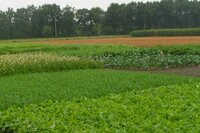-
A cover crop is a full crop

Late summer sown cover crops have a short growing season. Every day of delay costs tens of kilos of dry matter production per hectare and results in lower nitrate uptake from soil. Nitrogen deficiency frustrates solar radiation interception by cover crops and its conversion into biomass. They must therefore be grown as a full crop.
Green manure, catch crop, cover crop – the naming reflects the cultivation goal. All these crops must be able to intercept sufficient solar radiation, otherwise cultivation goals will not be achieved. They must therefore be grown as a full crop: seeded at correct depth, row distance and seed rate, preferably after seedbed preparation and fertilisation tailored to soil fertility and the need of the crop. In every day practice this is often not (fully) feasible, but it is a prerequisite for basic and applied research into the performance of cover crops and their mixtures.
Incomplete reporting
And that's where it often goes wrong. Research reports often lack information about the presence or absence of straw or other crop residues on the soil surface. The possible soil tillage prior to seeding the cover crops is often not communicated. Plant-available water content or soil matric potential (pF value) is almost always left unmentioned. Other soil characteristics are often also incompletely communicated. So, it remains to guess the crop’s supply of soil phosphorus, potassium or sulphur, not to mention the other essential and beneficial plant nutrients.
Experimental design
The lack of reported crop data suggests that the cover crops had not been treated as a full crop. This is what is happening in practice. Cover crops differing in nitrogen requirements are compared at the same (low) fertiliser nitrogen rate, without any adjustment to the soil mineral nitrogen (Nmin) level. Nitrogen deficiency is therefore often ingrained in the experimental design, which is fatal to a reliable comparison of radiation use efficiency, biomass production or nitrogen uptake. In addition, cover crops from different botanical families are usually sown at the same depth and row spacing. Everyone would be surprised if cereals, crucifers and legumes were compared with the same generalising approach. But it does happen with cover crops from those plant families. Such imperfections in experimental design and incomplete reporting complicate the interpretation of the results of studies that are very interesting in themselves.
The alternative - growing each cover crop according to its needs - is much more complicated. However, it does prevent a crop from underperforming. If cover crops or crop mixtures are compared, it gives a more realistic ranking with respect to biomass production or nitrogen uptake.
Cooperation of various disciplines
All-in all, researchers who study aspects of cover crop growing need sound information about cultivation practices in order to be able to set up good experiments. The necessary information is available, but is fragmented, so that cooperation of various disciplines is desired. This is how the cultivation of beet cyst nematode-resistant catch crops had been able to take off very quickly in Germany: an exemplary cooperation between researchers, plant breeders, nematode resistance testing organisations, consultants of phytosanitary authorities, sugar beet grower associations and the sugar industry, to quote the late German nematologist Josef Schlang. Maybe it is time for a green manure, catch and cover crop society and conferences where researchers can exchange ideas and knowledge with other stakeholders!
This editorial is published in the Plant nutrition courier magazine 2021-03 issue.